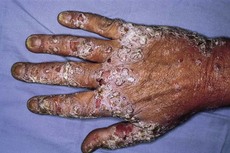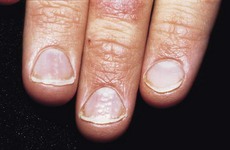152 Psoriasis
Salient features
History
• Symptoms (itching, pain, flexural intertrigo, limitation of manual dexterity), cosmetic problems or both
• Joint pains (psoriatic arthropathy (p. 481); psoriatic arthritis may be found in 10–15% of patients)
• Family history (30% of patients have family history)
• Aggravating factors (emotional stress, overuse of alcohol, streptococcal infections, drugs such as beta-blockers, lithium or tumour necrosis factor-α therapies).
Examination
• Well-demarcated salmon pink plaques with silvery white scales (Fig. 152.1) over extensor surfaces, scalp, naval and natal cleft. They often tend to have a pink or red line in the intergluteal fold
• A white blanching ring, known as Woronoff’s ring, may be observed in the skin surrounding a psoriatic plaque.
• Look at the nails for pitting (Fig. 152.2) and onycholysis (separation of the nail plate from the bed; p. 675)
Questions
Advanced-level questions
What are the types of psoriasis?
Depending on the nature of skin lesion
• With gradual peripheral extension, plaques may develop different configurations including:
• Rupioid and ostraceous, which relate to distinct morphological subtypes of plaque psoriasis:
• Inverse psoriasis: plaques evolve in the intertriginous areas and, therefore, lack the typical silver scale appearance because of moisture and maceration
• Guttate psoriasis: numerous small popular lesions with silvery scaling evolve suddenly over the body surface
• Pustular psoriasis: can be localized or generalized; superficial pustules may stud the plaques
• Erythrodermic psoriasis: generalized erythema and scaling; can be life threatening.
What do you know about the genetics of psoriasis?
• Clear identification of the causative gene has been difficult because of the extensive linkage disequilibrium (i.e. genes on one chromosome are inherited together and are not easily separable by recombination events) observed within the major histocompatibility complex (MHC).
• The major genetic determinant of psoriasis is PSORS1, which probably accounts for 35–50% of the heritability of the disease in multiple genomewide studies. PSORS1 is located within the MHC on chromosome 6p. Guttate psoriasis (an acute-onset form usually occurring in adolescents) is strongly associated with PSORS1,whereas late-onset cases of psoriasis vulgaris (usually in persons >50 years of age) and palmoplantar pustulosis are not associated with PSORS1.
• In a genomewide association study, polymorphisms in the genes for interleukin-12 (IL12B) and interleukin-23 (IL23R) are associated with psoriasis. These interleukins are cytokines that induce naive CD4 T cells to differentiate into type 1 helper T cells (Th1 cells) and type 17 helper T cells (Th17 cells), respectively; they have been identified as key mediators of psoriasis.
Mention a few exacerbating factors?
How would you manage a patient with psoriasis?
• Educate the patient that there is no cure and that only suppression of the disease is possible
• Indications for treatment include symptoms (itching, pain, flexural intertrigo, limitation of manual dexterity), cosmetic problems or both
• Weight loss and smoking cessation may lower the risk or severity of psoriasis
• Initial treatment is topical when <20% of the body is involved
• Topical therapy in some form is usually the mainstay of treatment and includes:
Russell B. Lepra, psoriasis, or the Willan–Plumbe syndrome. Br J Dermatol Syphilis. 1950;62:359-361.
B Russell, in 1950, proposed that psoriasis be known by the eponym Willan–Plumbe syndrome. The first clear descriptions were by Willan (1808) and Plumbe (1824) and ended hundreds of years of confusion and laid the foundation for establishing psoriasis as a disease entity that is separate from leprosy.








